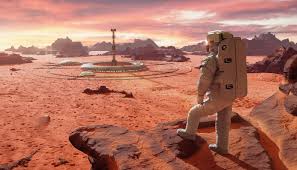Add your promotional text...
The plan of the space agency to lift humans to Mar
The plan of the space agency to lift humans to Mars would place two people in orbit, while two more astronauts would descend to the surface in an approximately 25-ton landing vehicle. NASA mentions that potential astronauts on this mission will need time to adapt to the Martian atmosphere. The researcher identifies 50 crucial points that fall into four broad categories for human exploration in general: infrastructure on the Moon and Mars, operations and science. "The comments we read about the targets we identified will inform our exploration plans on the Moon and Mars over the next 20 years," said Pam Melroy, NASA's deputy administrator, in a statement. "We are looking inside NASA and interested external parties to help us adjust these objectives and be as transparent as possible throughout our process. With this focus, we will find potential gaps in our architecture, as well as areas in which our objectives align with industry and international partners for future collaboration", added Melroy. The vision for a future mission to Mars was developed by Kurt Vogel, director of space architecture at NASA, who mentioned that the two members of the tripulation could survive inside a rover ensured that it could function as a habitat and an exploration vehicle, which would allow the seek critical scientific objectives. "Our assumption here is that the tripulation will be unconfirmed. It will take a long time to adapt to the partial gravity," said Vogel, who indicated that the surface of Mars is famous for holding approximately a third of the gravity we experience on Earth. "We will maximize our science to allow astronauts to manage before they are sufficiently conditioned to travel through space and travel and maximize our science in 30 days," explained Vogel. Added to the time of transit between Earth and Earth, a future mission to the surface of Mars and its return could last two years, but it could also involve 500 days on the surface, in which case a thousand days of our planet will not take long for the astronauts of the future. Therefore, 30 days feels more feasible than the psychological stress provoked by being part of Earth and on a completely different planet. Similarity, the logistical and financial needs of states extended across the world to ours could prove far too difficult to handle. At least, at least, this is how it is viewed on the first trip to Planeta Rojo. Later, after the Lunar Gateway is complete and operational in the orbit of the moon, NASA will build Transit Habitat, the colossal vehicle that serves as its purpose to provide refuge to astronauts on their long journeys before Mars.
IA ECONOMIST PONCE DE LEON
8/8/20251 min read


Contenido de mi publicación
